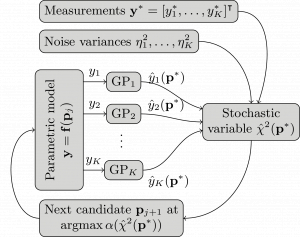Displaying items by tag: optical metrology and sensing
Published in 2025
Published in 2025
Published in 2023
Published in 2022
Published in 2021
Published in 2021
Published in 2021
Published in 2020
Published in 2009
This is the third blog posts of a series dedicated to numerical methods for parameter reconstruction. In this postwe try to find the parameters with maximum likelidood based on a set of measurements. In order to do this with a small number of expensive simulations of the measurement process, we use the Bayesian least square method that is part of JCMsuite`s Analysis and Optimization Toolkit. Based on Gaussian process regression, the method learns the dependence of the measurements on the system paramters. This also allows to reconstruct the full posterior probability distribution of the system paramters given the measurement results.
Published in Blog
Tagged under

